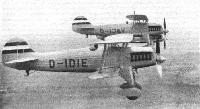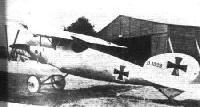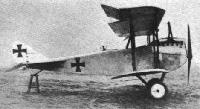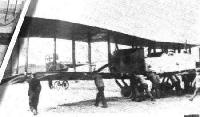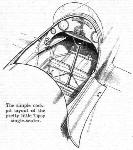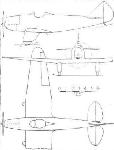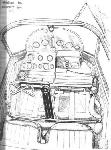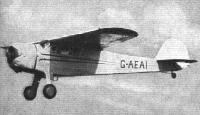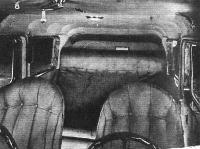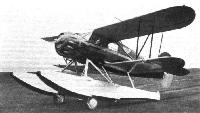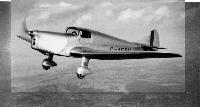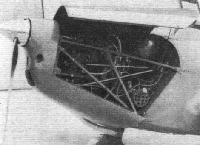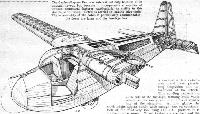Фотографии
-
A Staffel of the Second Group, Richthofen Squadron, Taking-off from Damm Aerodrome. The view shows the open nature of the country.
Самолёты на фотографии: Heinkel He-51 - Германия - 1933
-
Регистрационный номер: D-IQEE [2] The Heinkel He.51 "... reminded one of the old 1917 Albatros D.V. of the war, cleaned up, modernised, infinitely more powerful and faster." The civilian markings of German military aircraft are in some cases being discontinued.
Самолёты на фотографии: Heinkel He-51 - Германия - 1933
-
Регистрационный номер: D-IDIE [2], D-IJAY [2] Striking impression, from the German official publication Die Deutsche Luftwaffe of Heinkel He.51s. in formation. This is the type with which the Richthofen Squadron is equipped.
Самолёты на фотографии: Heinkel He-51 - Германия - 1933
-
Регистрационный номер: D-IDIE [2], D-IJAY [2], D-IQEE [2] Самолёты на фотографии: Heinkel He-51 - Германия - 1933
-
In this view of one of the Richthofen Squadron's Heinkel, the bomb-like auxiliary fuel tank between the undercarriage legs is just discernible.
Самолёты на фотографии: Heinkel He-51 - Германия - 1933
-
Регистрационный номер: G-ACJJ Самолёты на фотографии: Junkers Ju.52/3m - Германия - 1931Short Scylla / L.17 - Великобритания - 1934
-
Регистрационный номер: D1033/17 The successful Albatros D 5 fighter with 175 h.p. Mercedes. Note the modernity of line.
Самолёты на фотографии: Albatros D.V/D.Va - Германия - 1917
-
Регистрационный номер: NC15810 The fine lines ot the Beechcraft M.18 are brought out in the flying view.
Самолёты на фотографии: Beechcraft Model 18 / C-45 Expeditor - США - 1937
-
Note, on the instrument panel, the central space for Lear radio.
Самолёты на фотографии: Beechcraft Model 18 / C-45 Expeditor - США - 1937
-
Регистрационный номер: G-AEEL M.2X Hawk Trainer являлся самолетом первоначального обучения, после его освоения курсанты переходили на Miles M. 14 Magister. Hawk Trainer в больших количествах использовали британские ВВС. Самолет на фотографии был построен в 1936 году, а в 1940 году эти машины начали снимать с эксплуатации.
For modern instruction: The Miles Hawk Trainer, a machine which is designed primarily for the training of Service pilots in modern technique.Самолёты на фотографии: Miles Hawk / M.2 - Великобритания - 1932
-
The D. F. W. Aviatik Type C.V. with 228 h.p. Benz engine.
Самолёты на фотографии: DFW C.V - Германия - 1916
-
MAGISTER ARTIUM: Mr. F. G. Miles, past-master of the art of aircraft demonstration, reveals the qualities of the Miles Magister trainer (D.H. Gipsy Major) at a "family gathering" of Phillips and Powis employees last week when the prototype was christened with due ceremony by Mrs. Miles. The Magister is basically similar to the Hawk Trainer, but has been revised in detail. Note, for example, the new undercarriage and the tail wheel.
Самолёты на фотографии: Miles Magister / M.14 - Великобритания - 1937
-
A typical Gotha bomber with a pair of 260 h.p. Mercedes engines operating as pushers.
Самолёты на фотографии: Gotha G.II / G.III / G.IV / G.V - Германия - 1916
-
Регистрационный номер: K5115 FOR RAPID RAIDS: The Hawker light bomber with 1,000 h.p. - plus Rolls-Royce Merlin engine. There is a marked resemblance to the Hurricane. Points to note are the "belly" for the bombs and the D.H. v.p. airscrew.
Самолёты на фотографии: Hawker Henley - Великобритания - 1937
-
THE MERLIN'S PERCH: A close-up of the installation of the ethylene-glycol-cooled Rolls-Royce Merlin in the Hawker light bomber, revealing also the radiator intake and outlet, bomb traps and details of the Dowty retractable undercarriage with its toed-out Dunlop wheels. It will be noted that the new Rolls-Royce exhaust system, which does a certain amount of flame damping and silencing, is fitted. This offers considerably less resistance than the "ramshorns" used on several Kestrel-engined service types.
Самолёты на фотографии: Hawker Henley - Великобритания - 1937
-
A two-bay single-seater fighter - the Halberstadt Type D with 120 h.p. Argus engine.
Самолёты на фотографии: Halberstadt D.V - Германия - 1917
-
A plan view of the Gladiator is shown in this steeply banked turn above the clouds. Manoeuvrability is one of the attributes of the compact biplane and is combined with speed in this particular day-and-night fighter.
Самолёты на фотографии: Gloster Gladiator - Великобритания - 1934
-
The Gloster Gladiator Day-and-night Fighter
Самолёты на фотографии: Gloster Gladiator - Великобритания - 1934
-
NATIONAL SHOW: Contrasts in fighters at the National Aviation Show recently held in New York. The Seversky pursuit (1,000 h.p. Pratt and Whitney Twin Wasp) ordered in quantity by the U.S. Army Air Corps.
Самолёты на фотографии: Seversky P-35 - США - 1936
-
Регистрационный номер: D-AKOP A general view of the assembled machines at Almaza. Note the big Junkers Ju.86.
Самолёты на фотографии: Junkers Ju.86 - Германия - 1934
-
THE WEARING OF THE GREEN: An Avro Anson (two 310/355 h.p. moderately supercharged Siddeley Cheetah IXs) on test at Woodford prior to delivery to the Irish Free State Air Force, which is composed almost entirely of Avro aircraft. All its machines, including some Vickers Vespas, have Siddeley engines.
Самолёты на фотографии: Avro Anson / Type 652 - Великобритания - 1935
-
LEG SHOW: Members of the R.A.F. Staff College, Andover, in the undercarriage-erection department of Handley Page's Cricklewood works, where they inspected the methods used for the rapid production of large numbers of Harrow heavy bombers.
Самолёты на фотографии: Handley Page Harrow / H.P.54 - Великобритания - 1936
-
Регистрационный номер: G-AESU The latest Tipsy monoplane, which is powered with a dual-ignition Sprite engine and has a range of 470 miles at a cruising speed of 80 m.p.h. or more.
Самолёты на фотографии: Tipsy S - Бельгия - 1935
-
The simple cockpit layout of the pretty little Tipsy single-seater.
Самолёты на фотографии: Tipsy S - Бельгия - 1935
-
The Chilton monoplane, a high-efficiency ultra-lightweight with a Carden-Ford engine.
Самолёты на фотографии: Chilton D.W.1 - Великобритания - 1937
-
Регистрационный номер: G-AEJM THE LATEST EXPRESS: This aerial view of the D.H. 86B - actually one for Wrightways of Croydon - clearly shows the modifications that have been made, in the interests of improved full-load stability, to what used to be known as the "empennage."
Самолёты на фотографии: De Havilland Express Air Liner / D.H.86 - Великобритания - 1934
-
JERSEY'S AIRPORT: A sunny impression of the well-planned terminal building of Jersey's new airport, with a Jersey Airways' D.H. 86 in the foreground. The airport was officially opened on Wednesday of last week.
Самолёты на фотографии: De Havilland Express Air Liner / D.H.86 - Великобритания - 1934
-
Регистрационный номер: CF-AYI The D.H. "Hornet Moth" Seaplane (130 h.p. D.H. "Gipsy-Major" engine).
As might be expected, the Hornet Moth has an excellent performance as a seaplane. With two occupants and more than 100 lb. of luggage, the machine has a range of 316 miles while cruising at 95 m.p.h. Tests on a Canadian lake, lying some 1,500 ft. above sea level, showed that the Hornet was off a glassy surf ace after a 30-second run.Самолёты на фотографии: De Havilland Hornet Moth / D.H.87 - Великобритания - 1934
-
Регистрационный номер: G-ADNA For luxury ownership: The D.H. Dragonfly, aptly described as "an air liner in miniature," cruises at 127 m.p.h. for 885 miles with five occupants and their luggage.
Самолёты на фотографии: De Havilland Dragonfly / D.H.90 - Великобритания - 1935
-
Регистрационный номер: G-AEGY The latest Monospar De Luxe, which, in standard form, is fully equipped for day, night and blind flying with four occupants and their luggage.
Самолёты на фотографии: General Aircraft Monospar ST-25 Universal - Великобритания - 1935
-
The DeLuxe Monospar has a spectacle-type swing-over control column, and an excellent instrument layout.
Самолёты на фотографии: General Aircraft Monospar ST-25 Universal - Великобритания - 1935
-
Регистрационный номер: G-AEHJ The latest Phoenix, which carries five people on 200 h.p. and has one of the quietest cabins of any single-engined machine.
Самолёты на фотографии: Heston Phoenix - Великобритания - 1935
-
Easy ingress and egress and an excellent view for the passengers are features of the Heston Phoenix.
Самолёты на фотографии: Heston Phoenix - Великобритания - 1935
-
Регистрационный номер: G-AEPD Another lightweight single-seater - the Luton Minor.
Самолёты на фотографии: Luton Minor - Великобритания - 1937
-
Самолёты на фотографии: Luton Minor - Великобритания - 1937
-
Самолёты на фотографии: Luton Minor - Великобритания - 1937
-
There is a genuine saloon car effect about the interior of the Percival Vega Gull.
Самолёты на фотографии: Percival Vega Gull / K.1 - Великобритания - 1935
-
Регистрационный номер: G-ADUU SUNSHINE SOMEWHERE: A heart-warming picture, in these chilly British March days, ot the Short Empire Boat Cavalier at the Bermuda Air Base for her experimental Bermuda to New York flights. Leaning from the cockpit is Capt. Armstrong, the commander, and in uniform is First Officer Richardson (second pilot); in mufti on top of the machine is Mr Bell. Short Bros., and Mr. Hayuen, of the A.I.D., is behind the flag mast.
Cavalier, G-ADUU, on the slipway at Imperial Airways' Bermuda base in 1938.Самолёты на фотографии: Short Empire / S.23 - Великобритания - 1936
-
Регистрационный номер: G-ADUV SPLICING THE MAINBRACE: One of the new Shell refuelling tenders ministering to the Empire boat Cambria during a demonstration at Southampton last week These tenders carry 2,500 gallons of spirit and 200 of oil, and deliver the former at 120 gall./min. Twenty-one are under construction, by Dunstans, of Doncaster, Rowhedge Ironworks, of Colchester, and Thornycrofts. Others are being built for use along the routes.
Самолёты на фотографии: Short Empire / S.23 - Великобритания - 1936
-
Регистрационный номер: G-ADXL By dint of clean design, the Hillson Praga has an excellent performance for a machine with a 40 h.p. engine. Production is now in full swing.
Самолёты на фотографии: Praga E-114 Air Baby / E-115 / E-117 - Чехословакия - 1934
-
Signor Zapetta (on right) with his companion and the Italian F.N. 305 monoplane which won the Speed Contest at 185 m.p.h.
Самолёты на фотографии: Nardi F.N.305 - Италия - 1935
-
Регистрационный номер: PH-AMA AS IT WAS: The Dutch "safety-first" machine which was crashed while being demonstrated last week at Gravesend, preparatory to its serious introduction into this country. The Scheldemusch (Scheldt Sparrow), as it is called, is a single-seater cabin pusher which, with a 40 h.p. Praga B engine, has a maximum of 78 m.p.h. It has a steerable nose wheel and the undercarriage is arranged so that the tail cannot be depressed until full flying speed is reached. Either a "flown-in" or normal landing can be made, and slots, with differential ailerons, look after stalled safety in the air.
Самолёты на фотографии: De Schelde Scheldemusch - Нидерланды - 1935
-
Регистрационный номер: G-AEAI The American private-owner type: The Cessna.
Самолёты на фотографии: Cessna Airmaster / C-34 / C-38 / C-145 / C-165 - США - 1935
-
Регистрационный номер: NR1050 NATIONAL SHOW: Contrasts in fighters at the National Aviation Show recently held in New York. Major Al Williams' Grumman Gulfhawk (1,000 h.p. nine-cylinder Wright Cyclone)
Самолёты на фотографии: Grumman F3F - США - 1935
-
The American private-owner type: The Porterfield
Самолёты на фотографии: Porterfield 35 Flyabout - США - 1936
-
"Saloon car" interior appearance is the aim in the latest Stinson, another American type with British concessionaire.
Самолёты на фотографии: Stinson Reliant - США - 1933
-
PRIVATE AMPHIBIAN: After one has learnt to hold off, while landing, at about twice the height of a normal undercarriage, this Edo amphibian gear - shown fitted to a Waco - should have definite advantages. The tail of each float is hinged and sprung to take tail-down landing stresses and the whole gear weighs 175 lb more than the standard float arrangement.
Самолёты на фотографии: WACO C / S Series - США - 1931
-
M.11 выпускался в вариантах M.11A, M.11B и M.11C. На фотографии - M.11A.
One of the most interesting private owner's types to be introduced during the past year - the Miles Whitney Straight, comfortable two-seat cabin monoplane on familiar Miles lines.Самолёты на фотографии: Miles Whitney Straight / M.11 - Великобритания - 1936
-
A Villiers-Hay Maya I installed in the Miles Whitney Straight. The miniature fire-tube boiler is the oil tank.
Самолёты на фотографии: Miles Whitney Straight / M.11 - Великобритания - 1936
-
Spacious side-by-side seating in the Miles Whitney Straight.
Самолёты на фотографии: Miles Whitney Straight / M.11 - Великобритания - 1936
-
Регистрационный номер: NC17542 The American private-owner type: The Taylor Cub as a floatplane.
Самолёты на фотографии: Taylor Cub - США - 1931
-
FISH HAWK. A Hawker Osprey IV fleet fighter reconnaissance floatplane of the Mediterranean Cruiser Squadron in company with another of its species. The machine is the most recent version of the Osprey to go into service and is fitted with the supercharged 600/640 h.p. Rolls Royce Kestrel V engine.
Самолёты на фотографии: Hawker Osprey - Великобритания - 1930
-
Регистрационный номер: G-ADSO The two-seater Aeronca monoplane, which is now being built in this country.
Самолёты на фотографии: Aeronca C - США - 1929
-
Регистрационный номер: ZK-ADI, G-ADHA, ZK-ASP VIRGIN COUNTRY: A Fox Moth operated by Air Travel, N.Z., Ltd., flying down the Westland coast. In the background are Mt Cook and Mt. Tasman, the highest mountains in New Zealand. Sqdn.-Ldr. T. D. Hewett is the pilot.
Самолёты на фотографии: De Havilland Fox Moth / D.H.83 - Великобритания - 1932
-
Регистрационный номер: G-AERP Designed to be flown by the novice pilot: the Dart Kitten, at present fitted with a 7 h.p. Ava flat-four two-stroke engine.
Самолёты на фотографии: Dart Kitten - Великобритания - 1937
-
The Drone pilot has an excellent view and is free of airscrew slipstream.
Самолёты на фотографии: Kronfeld Drone - Великобритания - 1932
-
Регистрационный номер: G-ADDB Best known of the British Aircraft range, the Swallow has made an enviable reputation for itself both as a trainer and a private owner's machine. It may be fitted either with a Pobjoy or a Cirrus engine.
Самолёты на фотографии: British Klemm L.25 Swallow - Великобритания - 1933
-
Mr. Philip Wills, holder of the British distance record, and the Abbott-Baynes Scud II, holder of the British height record (piloted by Flt. Lt. Buxton). Scud II is not a high-performance machine, but for height records this is not so important as strong construction and a very high degree of skill in the pilot.
Самолёты на фотографии: Abbott-Baynes Scud - Великобритания - 1931
-
A Rhonadler at Dunstable: In spite of the absence of fixed tail-plane, the very small fixed fin and the highly tapered wing, this machine is remarkably stable. It is easy to fly safely but very difficult to fly well enough to achieve the performance of which it is capable.
Самолёты на фотографии: Schleicher Rhonadler - Германия - 1932
-
It is difficult to imagine anything "cleaner" than the Rhonadler. It is so clean, in fact, that a highly varnished finish is well worth while - and for competition flying it is wax-polished all over.
Самолёты на фотографии: Schleicher Rhonadler - Германия - 1932
-
Регистрационный номер: G-GAAA [2] Launching Hjordis I: Although the span is 50 ft., the chord is very narrow, and the wing loading is unusually high for sailplanes. On this machine Mr. Wills broke the British distance record by flying from Dunstable to Lowestoft, 105 miles.
Самолёты на фотографии: Buxton Hjordis - Великобритания - 1935
-
Регистрационный номер: G-GAAA [2] Hjordis I over Sutton Bank. The first really high-performance sailplane designed and built in England (by Slingsby Sailplanes of Kirby Moorside). Stability has been to some extent sacrificed to performance. Controls are very effective, but have no "feel," and Hjordis gathers speed very rapidly indeed if the nose is allowed to fall by 2 or 3 degrees.
Самолёты на фотографии: Buxton Hjordis - Великобритания - 1935
-
Inexpensive simplicity: the Brawny monoplane in flight.
Самолёты на фотографии: Broughton-Blayney Brawny - Великобритания - 1936
-
Регистрационный номер: G-AEOG The Hordern-Richmond Autoplane, which is expected shortly to be put into production
Самолёты на фотографии: Hordern-Richmond Autoplane - Великобритания - 1936
-
These two sketches illustrate the ingenious "turntable" wing-folding system of the Carden-Baynes Bee.
Самолёты на фотографии: Carden-Baynes Bee - Великобритания - 1937
-
The Carden-Baynes Bee is of interest not only because of its unusual layout but because it incorporates a number of unusual structural features, particularly, as visible in this sketch, in the wing. Petrol is carried in leading edge tanks. The accessibility of the cabin is particularly commendable: the doors are large and the fuselage low.
Самолёты на фотографии: Carden-Baynes Bee - Великобритания - 1937
-
The new Nagler Helicogyro can be flown either as a helicopter or as a machine with windmilling rotor.
Самолёты на фотографии: Nagler Helicogyro - Великобритания - 1934
-
Stressed-skin in miniature: the CW. Cygnet Minor, which should shortly be flying.
Самолёты на фотографии: C.W. Aircraft Cygnet - Великобритания - 1937
Статьи
- Flight
- Flight Advertisements


